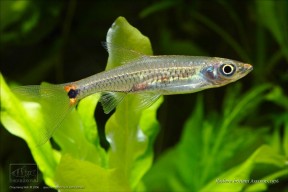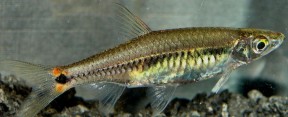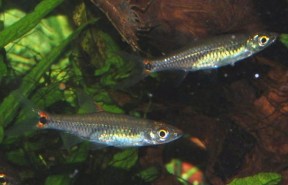Kottelatia brittani
SynonymsTop ↑
Rasbora brittani Axelrod, 1976
Etymology
Kottelatia: named in honour of Swiss ichthyologist Maurice Kottelat (1957-), author of numerous species and several genera of rasborins.
brittani: named in honour of Martin R. Brittan (d. 2008), monographer and reviser of Rasbora (the genus in which this species was described) and “close personal friend”.
Classification
Order: Cypriniformes Family: Cyprinidae
Distribution
This species’s distribution is unclear. It was described from Segamat District within the the Johor River watershed, Johor state, southern Peninsular Malaysia, but the type specimens were obtained via a Singapore wholesaler so it’s possible that a mistake was made as there exist no other records of the species in Peninsular Malaysia.
Type locality is ‘Johore River, Segamat, Malaysia’.
Specimens collected from the Kapuas drainage in Kalimantan Barat (West Kalimantan) province, Indonesia (Borneo) and initially identified as this species were subsequently described as Rasbora kalbarensis (Kottelat, 1991). There appears to be a possibility that it is endemic to Sumatra, since a record from the Batang Hari river, in Jambi province (Tan & Kottelat, 2009) appears to represent the first official record since the description was published.
Habitat
Presumably inhabits quiet forested streams and tributaries containing relatively clear water, although we’ve been unable to obtain any definitive information to date.
Maximum Standard Length
50 – 60 mm.
Aquarium SizeTop ↑
An aquarium with a base measuring 75 ∗ 30 cm or more should be used.
Maintenance
Choice of décor is not as critical as water quality although it tends to display better colouration when maintained in a well-planted set-up with a dark substrate. The addition of some floating plants and driftwood roots or branches to diffuse the light entering the tank also seems to be appreciated and adds a more natural feel.
Do not add this fish to a biologically immature tank as it can be susceptible to swings in water chemistry, and be sure to add a tightly-fitting cover since it is an accomplished jumper.
Water Conditions
Temperature: 20 – 26 °C
pH: Generally said to do best under acidic conditions but SF members who have kept it say that it prefers neutral pH. A value within the range 6.0 – 7.5 should be ok.
Hardness: 18 – 143 ppm
Diet
Likely to prey on small insects, worms, crustaceans and such like in nature. In the aquarium it will accept dried foods of a suitable size but also offer daily meals of small live and frozen fare such as Daphnia or Artemia.
Behaviour and CompatibilityTop ↑
This species makes an ideal addition to a well-chosen community but will not compete well with much larger or more boisterous species.
In a biotope-style arrangement you could try it alongside other species from the Batang Hari drainge such as Desmopuntius johorensis, Rasbora cephalotaenia, R. einthovenii, Brevibora doorsiocellata, Trigonopoma pauciperforatum, T. gracile, Trigonostigma hengeli, Pangio anguillaris, P. oblonga, or P. semicincta. It also makes an ideal companion for timid anabantoids such as Sphaerichthys or the more diminutive Betta species.
It is a schooling species by nature and really should be kept in a group of at least 8-10 specimens. Maintaining it in decent numbers will not only make the fish less nervous but will result in a more effective, natural-looking display. Males will also display their best colours as they compete with one other for female attention.
Sexual Dimorphism
Mature females are noticeably deeper-bodied and often grow a little larger than males.
Reproduction
An egg-scattering free spawner exhibiting no parental care. In a well-planted, mature aquarium it’ is possible that small numbers of fry may start to appear without intervention.
However if you want to maximise yield a more controlled approach is required. The adult group can still be conditioned together but a smaller tank with a base measuring around 45 cm x 30 cm should also be set up and filled with mature water. This should be very dimly lit and the base covered with some kind of mesh of a large enough grade so that the eggs can fall through but small enough so that the adults cannot reach them.
The widely available plastic ‘grass’-type matting can also be used and works well, as does a layer of glass marbles. Alternatively filling much of the tank with a fine-leaved plant such as Taxiphyllum spp. or wool mops can also return decent results. The water itself should be of slightly acidic to neutral pH with a temperature towards the upper end of the range suggested above. An air-powered sponge filter or air stone(s) should also be included to provide oxygenation and water movement.
When the adults are well-conditioned and the females appear gravid one or two pairs should then be introduced. If ready spawning usually taking place within 24 hours, signified by the female appearing noticeably slimmer. After 48 hours the adults should be removed whether spawning has occurred or not.
Incubation is temperature-dependant to an extent but typically lasts 18-28 hours with the young free-swimming 1-2 days later. Initial food should be Paramecium or similar, introducing Artemia nauplii, microworm, powdered dry foods, etc., once the fry are large enough to accept them.
NotesTop ↑
This species is a rare find but may be seen on sale with the trade name ‘head and tail light rasbora’ when it is available. It has been confused with the similar-looking Rasbora kalbarensis on occasion but can be identified by its larger adult size, more pointed head profile and intense orange to red blotches on the caudal peduncle.
The body of R. kalbarensis is also suffused with a pinkish hue, while K. brittani lacks a symphyseal knob on the lower jaw, the small projection which is present in all Rasbora species.
The genus Kottelatia is told apart from other rasborins by the following characters: palatine process slender with a narrow base, and very long in length without projection; coronoid process enlarged; plate-like expansion anteroventrally on dentary absent.
Rainboth (1996) characterised members of Rasbora by possession of an unbranched, non-spiny first dorsal fin ray and seven soft dorsal rays, origin of the dorsal fin in the middle of the body, five branched anal fin rays, a small mouth not extending below the eye and a lack of barbels. It has long been recognised as a polyphyletic lineage, and Liao et al. (2010) proposed a number of taxonomical changes based on the results of their phylogenetic analysis.
The authors found species of rasborin genera to represent a monophyletic grouping existing in six clades, and erected four new genera (all containing former members of Rasbora) in order to preserve monophyly of the existing groups; Boraras, Horadandia, Rasbora, Rasboroides and Trigonostigma.
The first clades is monotypic, comprising only Kottelatia brittani (formerly Rasbora brittani) while the second contains the genus Brevibora. The third clade comprises Boraras, Horadandia, Rasboroides, Trigonostigma and three species previously included in Rasbora but moved into new genera; Trigonopoma gracile, T. pauciperforatum and Rasbosoma spilocerca. The results for Boraras and Trigonostigma were found to be inconclusive in some respects and further work regarding their phylogenetic position was recommended.
The fourth clade includes Rasbora semilineata, R. borapetensis, R. rubrodorsalis and an undescribed fish similar to R. beauforti. Clade five consists of R. daniconius, R. hubbsi, R. paucisqualis, R. wilpita, R. kobonensis, R. ornata and R. cf. daniconius. Clade six, meanwhile, is subdivided into two groupings.
The first contains R. einthovenii, R. elegans and R. cephalotaenia and the second R. lateristriata, R. argyrotaenia, R. volzii, R. paviana, R. rasbora (plus an undescribed, similar fish), R. caudimaculata and R. trilineata. As this final clade contains the type species (see below) its members retain the generic name Rasbora as do clade five species because they don’t differ sufficiently to warrant the erection of a new genus/genera.
Unfortunately many species weren’t included in the analysis, meaning inevitable questions are raised regarding the correct placement of the 40 or so other Rasbora spp., in particular. As the genus had previously been split into various ‘species groups’ (groups of closely-related species) dating back to Brittan (1972, who referred to them as ‘species complexes’) Liao et al. proposed the following arrangement whilst noting it may be subject to change with further phylogenetic studies:
R. semilineata species group: R. semilineata, R. borapetensis, R. rubrodorsalis.
R. trifasciata species group: R. trifasciata, R. amplistriga, R. bankanensis, R. dies, R. ennealepis, R. hubbsi, R. johannae, R. meinkeni, R. paucisqualis, R. rutteni, R. sarawakensis, R. taytayensis, R. tobana, R. tuberculata.
R. daniconius species group: R. daniconius, R. caverii, R. kobonensis, R. labiosa, R. ornata, R. wilpita.
R. einthovenii species group: R. einthovenii, R. cephalotaenia, R. elegans, R. jacobsoni, R. kalochroma, R. kottelati, R. nematotaenia, R. tubbi.
R. argyrotaenia species group: R. argyrotaenia, R. aprotaenia, R. aurotaenia, R. baliensis, R. borneensis, R. bunguranensis, R. dusonensis, R. evereti, R. hobelmani, R. hossi, R. lateristriata, R. laticlavia, R. leptosoma, R. philippina, R. septentrionalis, R. spilotaenia, R. steineri, R. tawarensis, R. tornieri, R. volzii.
R. sumatrana species group: R. sumatrana, R. atridorsalis, R. calliura, R. caudimaculata, R. dorsinotata, R. notura, R. paviana, R. rasbora, R. subtilis, R. trilineata, R. vulgaris.
Not classified: R. beauforti, R. chrysotaenia, R. gerlachi (validity in question), R. kalbarensis, R. reticulata, R. vulcanus (possibly not Rasboras) and R. zanzibarensis (identity in question).
Shortly afterwards a paper investigating systematics of the subfamily Danioninae was published (Tang et al. 2010) with significantly different results. The four new genera proposed by Liao et al., plus Boraras and Trigonostigma, were synonymised with Rasbora based on an incomplete knowledge of relationships within the group, an approach described as ‘more conservative’. Though perhaps neither conclusion is satisfactory we decided to adopt the system of Liao et al. pending future studies, if only because Boraras and Trigonostigma are well-known genera in the aquarium hobby.
The identity of the type species, often given as R. rasbora in the past, is no longer in question; when Bleeker first referred to the name Rasbora in 1859 only four nominal members were included of which R. cephalotaenia (known as Leuciscus cephalotaenia at the time) should be considered the type. Howes (1980) suggested the separation of a number of species into the new genus Parluciosoma with type species P. (Rasbora) argyrotaenia but the monophyly of that grouping was not recovered in phylogenetic analyses.
References
- Axelrod, H. R., 1976 - Tropical Fish Hobbyist 24(6): 94-98
Rasbora brittani, a new species of cyprinid fish from the Malay Peninsula. - Kottelat, M., 1999 - Raffles Bulletin of Zoology 47(2): 591-600
Nomenclature of the genera Barbodes, Cyclocheilichthys, Rasbora and Chonerhinos (Teleostei: Cyprinidae and Tetraodontidae), with comments on the definition of the first reviser. - Kottelat, M., 2013 - Raffles Bulletin of Zoology Supplement 27: 1-663
The fishes of the inland waters of southeast Asia: a catalogue and core bibiography of the fishes known to occur in freshwaters, mangroves and estuaries. - Liao, T. Y., Kullander, S. O. and F. Fang, 2010 - Zoologica Scripta 39(2): 155-176
Phylogenetic analysis of the genus Rasbora (Teleostei: Cyprinidae). - Mayden, R. L., K. L. Tang, K. W. Conway, J. Freyhof, S. Chamberlain, M. Haskins, L. Schneider, M. Sudkamp, R. M. Wood, M. Agnew, A. Bufalino, Z. Sulaiman, M. Miya, K. Saitoh, and S. He, 2007 - Journal of Experimental Zoology, Molecular Development and Evolution 308B: 1–13
Phylogenetic relationships of Danio within the order Cypriniformes: a framework for comparative and evolutionary studies of a model species. - Tan, H. H. and M. Kottelat, 2009 - Ichthyological Exploration of Freshwaters 20(1): 13-69
The fishes of the Batang Hari drainage, Sumatra, with description of six new species. - Tang, K. L., M. K. Agnew, W. J. Chen., M. V. Hirt, T. Sado, L. M. Schneider, J. Freyhof, Z. Sulaiman, E. Swartz, C. Vidthayanon, M. Miya, K. Saitoh, A. M. Simons, R. M. Wood and R. L. Mayden, 2010 - Molecular Phylogenetics and Evolution 57(1): 189-214
Systematics of the subfamily Danioninae (Teleostei: Cypriniformes: Cyprinidae).







